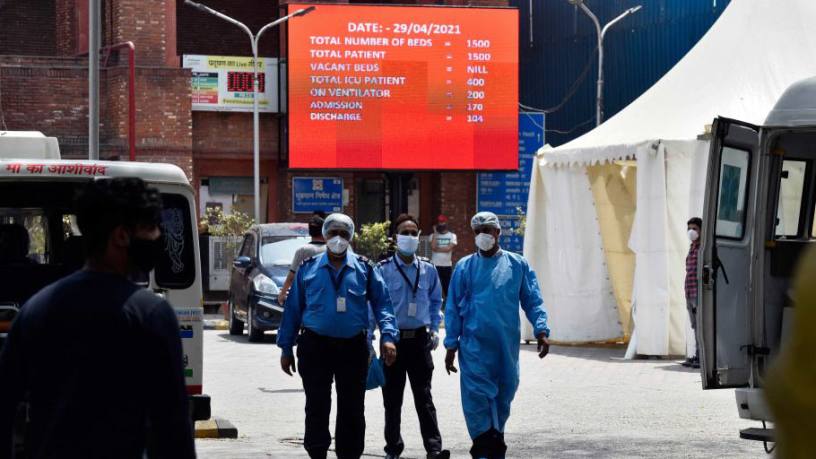India is experiencing one of the most shocking increases in the number of Covid-19 cases since the start of the pandemic. The country saw daily cases peak at 414,000 cases per day on May 6th, and at the time of writing an official death toll of over 262,000, although estimates on the ground suggest the number could be as much as three times higher.
Amid this devastating wave, the country’s economy lumbers on. In a note published by S&P, the ratings agency stated that a slowdown to the country’s recovery might prompt a revision to its base-case assumption of 11% growth during the financial year to 2022. “The country already faces a permanent loss of output versus its pre-pandemic path, suggesting a long-term production deficit equivalent to about 10% of gross domestic product,” it cautions.
State of emergency
Across the country, steps are being taken to suppress the spread of the virus. Despite coming in for robust criticism over their recent handling of the pandemic, prime minister Narendra Modi’s government has taken a localised approach to lockdowns. Saswata Guha, senior director and team head at Fitch, says that these lockdowns are reducing economic activity, with the 12 most affected cities experiencing economic activity at around 60% of that seen during the first quarter of 2021.
Individual organisations are taking steps to protect their employees. The Indian Banks’ Association (IBA) has announced it will reduce bank working hours to four hours per day, and reduce staff numbers to 50% on a rotational basis.
The role played by vaccines in curtailing the pandemic has now become more important. “The speed of India’s vaccination rollout will play a vital role in the economic recovery,” says Deepali Seth-Chhabria, banking analyst at S&P. “This basis is reasonably strong from an emerging market perspective: India has administered one of the largest numbers of vaccines globally, at 178 million doses, and the number is rising daily. This is behind only the US and China, and the EU, but given the size of the country’s population, it is a considerably lower rate per capita than many other countries.”
After criticisms over the cost of vaccines, steps have been taken to reduce the price. The AstraZeneca vaccine is being produced locally under the brand name Covishield, and manufacturer Serum Institute of India has stated it will reduce the cost from Rs400 to Rs300 ($5.40 to $4.05). The international community has pledged to provide additional support in the form of vaccines, ventilators and oxygen, and countries across Asia are particularly keen to suppress the spread of the virus due to fears of contagion.
Business support
At the beginning of the pandemic, the government and central bank the Reserve Bank of India stepped up with support for local banks and businesses.
“One feels a sense of caution coming from the banks at the moment,” Mr Guha says. “The earnings season is currently underway, and the numbers have generally been better than what we had expected back in 2020. This is primarily because a significant share of stress remains unrecognised on bank balance sheets thanks to the forbearance and relief measures that were extended by the authorities.”
Ms Seth-Chhabria says the banks have received support: “The government has been providing capital to the public sector banks, and we have seen both the public sector and the private sector banks tapping the markets to raise capital. The provision coverage is now at one of the highest levels of the past 20 years, at about 75%. There are some buffers that should guide the way to the path of recovery.”
We believe the government and the central bank will remain supportive of the banking system
Mr Guha agrees: “The private sector banks are in a better position than the public sector, as they have in place capital buffers to be able to withstand some of the stress. Public sector banks are comparatively much less endowed, and still grappling with their legacy bad assets, weak profitability and impact of the first wave. I believe we will see the private banks recover sooner than the public sector banks.”
Vulnerable small and medium-sized enterprises (SMEs) have been the primary beneficiaries of forbearance measures, which have been extended to June 2021. Banks were able to restructure corporate loans and provide refinancing to SMEs of up to 30% of the outstanding loan as a revolving credit facility.
There have been recent reports of non-bank financial institutions sending a proposal to the regulator to extend the SME credit guarantee refinancing scheme until March 2022.
“While the SME forbearance has been extended already, we believe there is a high probability for it to get further extended,” says Mr Guha. “I don’t think it will be too out of place if the authorities choose to extend restrictions for an extended period of time to deal with the high infection rate.”
Although the extension of support to SMEs has yet to be confirmed, Ms Seth-Chhabria says there will be more assistance in the pipeline: “We believe the government and the central bank will remain supportive of the banking system. The weak loans will remain elevated at between 11% and 12%, and credit costs will also remain high at about 2.2% of the total loans during the current year, before recovering to 1.8% the following year.”
Economic stability
India has long had high levels of non-performing loans (NPLs). In its note, S&P stated that lenders’ asset quality has remained strained, although the country’s economic recovery to March 2021 had alleviated some of the NPL stress.
During March 2021, the IBA released the results of its survey with the Federation of Indian Chambers of Commerce & Industry, covering July to December 2020. The report showed there had been an increase in optimism as the economy had grown. A decline in NPLs was reported by 50% of respondent banks.
The potential for prolonged difficulties had already been noted. “Our projections already factor in some of the weakness that could emerge from the second wave and the resultant lockdowns, and so far the performance has been better than expected, providing some cushion to our forecast,” says Ms Seth-Chhabria. “The banks have also been building capital buffers and reserves; Covid-19-related provisions are somewhere in the region of 0.5% to 1% of their total loans.”
The Asian Development Bank’s Asian Development Outlook report published in April 2021 predicts growth of 11% in 2021, after a decline of 8% in 2020. A growth rate of 7% has been forecast for 2022.
Mr Guha says that there are other banking sectors which may be in need of support: “The other concern area is the unsecure retail space. We believe this is the most vulnerable retail asset class as individual incomes and savings are further impacted in the wake of this ongoing second wave,” he says.
Ultimately, India’s ability to recover comes down to how fast the country can bring the current wave of the pandemic under control.
“I think the overall business opportunities are likely to remain muted for at least two quarters, considering the spread of the virus,” Mr Guha says. “A lot depends on how long it takes to rein in infections and get the population vaccinated, particularly in the 12 hotspots.”













